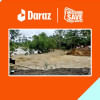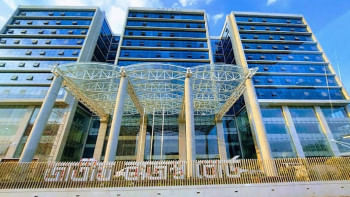Why has the government’s flood response been so slow?

Kabir Ahmed, a 65-year-old sharecropper from Jagatpur village in Feni's Fulgazi upazila, lost his two tin-shed houses when the embankment of the Muhuri River breached on August 22. Floodwaters destroyed Kabir's home, forcing him to seek shelter at a neighbour's house with his seven family members and his cattle.
On September 15, The Daily Star published a story about Kabir online. After that, an NGO visited him, offering to build him and his family a new house. Kabir refused the offer, his reason being that without repairing the embankment, any new house would be washed away by the next flood. As a result, the NGO left without providing assistance.
On September 14, we met another farmer, Md Alam, from the same village. One of his five cows died in the August flood. He is now in great distress, feeding banana plants to the remaining four cows as the flood washed away all his hay and there is no grass left on the croplands. The district livestock officer (DLO) mentioned they received only Tk 5 lakh to distribute to the flood-affected farmers for fodder.
According to an official from Bangladesh Water Development Board's (BWDB) Feni office, around three kilometres of the 122-kilometre embankment along the Muhuri, Kahua, and Cilonia rivers in Parshuram and Fulgazi upazilas were damaged. Due to a lack of fund allocations, the local water development office could not begin repair work until September 22. Meanwhile, 200 hectares of Aman paddy fields have been buried under one to five feet of sand, which were carried by floodwaters from upstream India.
Officials from the Parshuram upazila agricultural extension advised farmers to switch to cultivating alternative crops, as paddy cultivation would not be feasible for the next three to four years due to the sand deposits. Solaiman Ali, a farmer from West Aloka village, lost 12 bighas of land to three to five feet of sand. He now faces uncertainty about how he will provide for his family without cultivating Aman rice in the coming season.
These are some of the stories we gathered from a visit to the flood-affected areas of Noakhali and Feni on September 10-16. However, as of September 19, a month after the floods, the government has yet to begin rehabilitation work.
According to the Noakhali district administration, around 50,000 houses were damaged by the floods. On September 17, Disaster Management and Relief Adviser Farooq-e-Azam told journalists that the August flood had caused a total financial loss of Tk 14,269.68 crore and claimed 74 lives across 11 districts in the eastern part of the country. Around 45.5 lakh people had to leave their homes and take shelter elsewhere during the flood.
This raises several questions. Why hasn't the government started rehabilitation work yet? Why is the damage assessment taking so long? Why will it take the district administration officials a month to prepare a list of victims? Why are flood-affected people still homeless a month later? Why is Kabir Ahmed still taking shelter in someone else's house after all this time? Why are farmers in Parshuram upazila still in the dark about when they can clear the sand from their cropland?
Has the government even considered addressing these questions?
The August flood was the worst flood in the country since 1988. In some areas of Feni, water levels rose as high as the second floor of some buildings. Many people are still reeling from the trauma; many formerly well-off families have lost their stored food, farmland, crops, and livestock, and are living in precarious conditions.
I am familiar with the floods that occur every year in the northern parts of the country, where the Teesta, Brahmaputra and Jamuna river basins overflow due to upstream flow. Flooding in this region mainly occurs in the char areas, and people there have learnt to cope with it since childhood. Normally, if the embankment holds, there is no flooding in the mainland. But this time, the eastern mainland was hit, leaving many people who don't have experience of big floods to face the worst flood in their lives. The government should have acted swiftly to help them return to normal life. Instead, it remains bogged down in bureaucratic delays. Rehabilitation can only begin once bureaucrats finalise their victim lists, a process that is taking far too long. There needs to be a rapid assessment team during floods and another one to mobilise quick responses.
There are many examples where we witnessed local administrations and ruling party members distributing blankets after winter was gone and the temperature started to rise. These instances were not just laughable—they were tragic.
According to the US Department of Agriculture (USDA), the recent floods damaged 200,000 hectares of crops, including paddy seedlings. The agency has predicted that Bangladesh will have a shortage of rice compared to its target this year. Had the government taken quick actions, farmers could have replanted Aman within the necessary time frame.
The flood-affected farmers were unable to arrange seeds, fertilisers and other means of production post-flood. As a result, thousands of hectares of Aman paddy land remain uncultivated across the 11 flood-affected districts. If the government had provided cash incentives, fertiliser and seeds immediately after the water receded, these lands might not have remained fallow.
After independence, this is the first time that people from all walks of life have extended such massive help to flood-affected people, which is truly wonderful. At Dhaka University's TSC, many children even came out with their parents to donate the savings they had collected for years. For the older generation, this was a remarkable and heartwarming sight.
Following the mass uprising and this public mobilisation, the government should consider reforming the outdated bureaucratic system. People are ready for change, and the government should follow suit. Ultimately, to bring about any meaningful reform, the government must prioritise saving farmers from natural disasters to ensure increased agricultural production.
Mostafa Shabuj is a journalist at The Daily Star.
Views expressed in this article are the author's own.
Follow The Daily Star Opinion on Facebook for the latest opinions, commentaries and analyses by experts and professionals. To contribute your article or letter to The Daily Star Opinion, see our guidelines for submission.

 For all latest news, follow The Daily Star's Google News channel.
For all latest news, follow The Daily Star's Google News channel. 











Comments